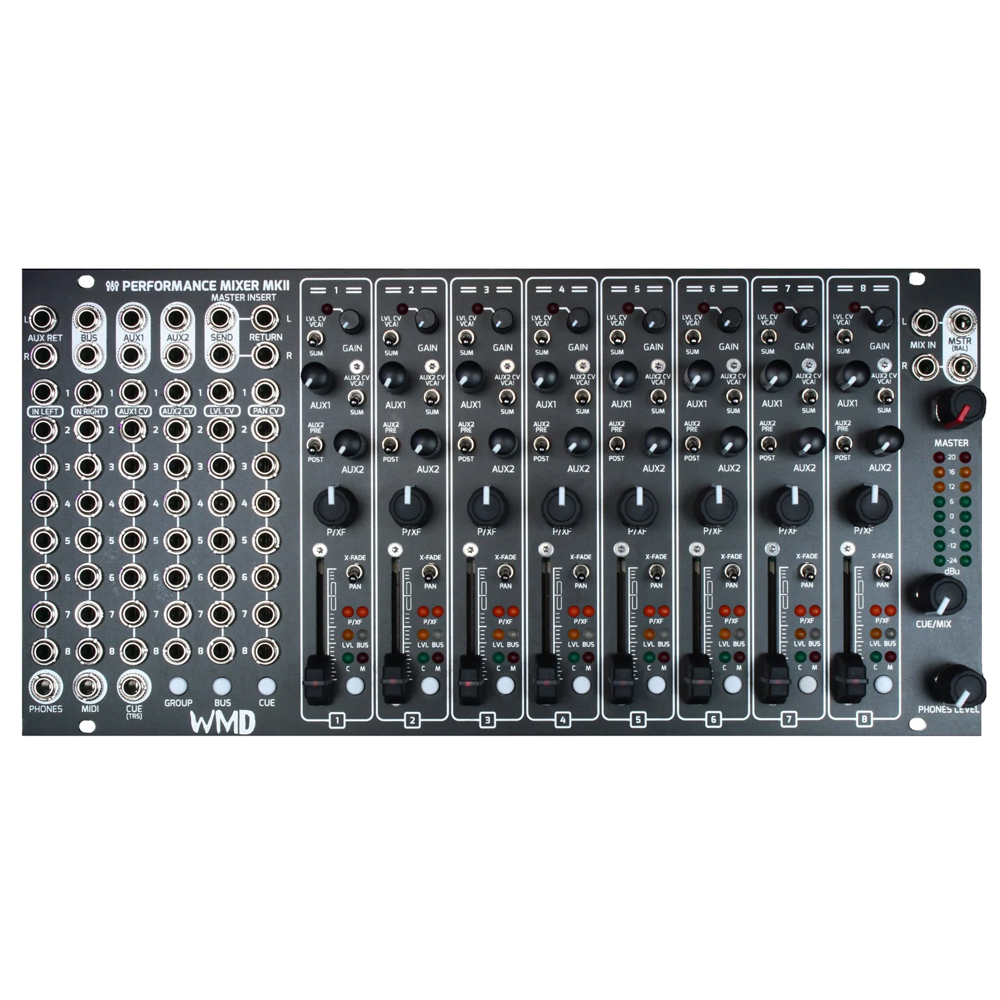Enter the WMD Performance Mixer MKII – Eight years after the MKI was released, the MKII builds on all the valuable feedback we’ve received. This is a serious upgrade, with feature enhancements and engineering improvements affecting every bit of the design.
The original Performance Mixer changed the eurorack landscape when it first came out, it made mixing much more intuitive and instant, it allowed people to ditch the heavy outboard mixer, and keep their system patched while they traveled. It made using individual drum modules and multiple voices easy to keep straight in a packed dark room. We know this because you all wrote us with praise, and with suggestions to make it better. Almost all of those suggestions have been engineered and are in the new unit, plus a few features that push the concept further.
Upgrades
- Noise Performance 2 – On the Original, the Level VCA was before the Panning VCAs, which saved on parts/power, but it meant that the Panning VCAs were always connected to the mix bus, adding noise floor that couldn’t be attenuated. Making all the channels stereo and putting the Pan circuit first eliminated this problem, now the noise add is controlled by the fader. This did force me to make every channel stereo, so the design got simpler through figuring this out.
- Panning / Crossfader – The above panning/level improvement made it possible to convert the Pan control into a crossfader, buy simply routing the post pan signals through a switch to the opposing channel, summed at the Level control. This huge improvement allowed the A/&/B input switching scheme to still work on the PM MKII, a bit differently, but its there in spirit.
- Modular Design – The channel strips are all now stereo, and identical, which makes assembly much easier, and lowers the cost. It also makes replacing them easier should a mechanical part fail or get spilled into. Further, the Patchbay, Power board, and Master section are all separate parts, so if there’s a failure, they can be quickly swapped without having to RMA the whole unit.
- Patchbay – The MKI and rev E MKII still had jacks misaligned with channels. This was a source of frustration for myself and many users of the PM MKI. And I decided to just be done with it. It didn’t make sense to try to put jacks over the channel, it wasted too much space on the panel… So all the jacks go left, keeping the mixer clear of cables, this let me space the knobs out a bit to take up all 3U. It’s cleaner, simpler to make, and intuitive to use.
- Expandability – It’s super modular now, the DB25 can connect to any two headers that spits out audio, they’re all the same format across PM MKII and Channels MKII. Pre, post, mixes, connect it however you want. And the connectors can’t be hooked to power, meaning no more blown opamps and RMAs to the factory. They’re all shrouded too so they won’t get bent in shipping!
Features
- 8 Stereo or Dual Mono Inputs
- 2x Stereo Auxes
- Balanced (TRS) Main Outputs
- Soft Mute Per Channel
- Group Button for Simultaneous Cue/Mute/Bus routing Changes
- Pan/Crossfade Switch for dual mono inputs per channel (panned center)
- Second Bus for Submixing (and/or operation)
- Stereo Cue Mix Bus (TRS Output Jack)
- 3.5mm Headphone Jack with Cue/Mix pot
- MIDI output sends CCs for Pan, Level, Aux1, Aux2 positions – Capture your mix in your DAW
- Rear Headers for Pre and Post Fader/Pan outputs to DB25/3.5mm Jacks
- Clip Indicator on Input Gain Pot
- LEVEL and AUX2 CV can SUM or operate as VCAs
- AUX2 can be Pre Fade or Post Fade
- Channel strips are field replaceable if a pot or fader fails.
- Expandable up to 24 Stereo Channels
- Returns Expansion adds 3x AUX return stereo inputs
- CV control over Pan, Level, Aux1, and Aux2
- CV flows to MIDI
- Channel Inserts: Rear cables per channel allow for future insertable effects
- Firmware update via Memory Card
- Integrated Soft Start on Power Up
Specifications
- Width: 52hp
- Depth: 36mm
- Power: +12V 550mA / -12V 520mA

 switch to the E.U site >
switch to the E.U site >